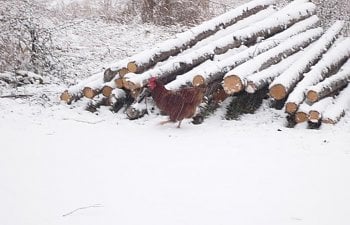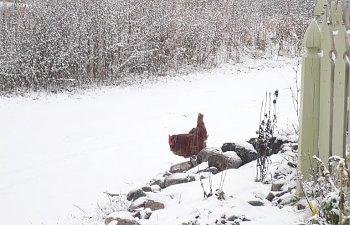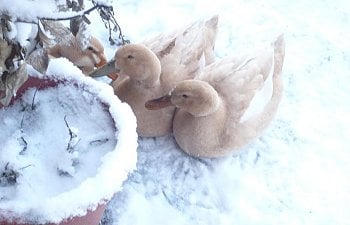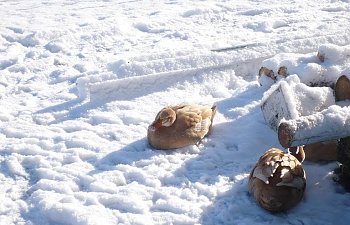Wintering With The Flock
Our experience wintering with 19 hens and 3 ducks in the often frigid Ontario countryside!

As much as we'd like to say we're very organized and prepared for the weather we know will come, we certainly are not prepared at all. That said, we do our best throughout the winter to make life as comfortable as possible for our hens and ducks.
When we first started out with 15 chickens last summer we renovated a 90 year old ice house next to our house on our 8 acre hobby farm. It was very important to us that we insulate our chicken barn, even if it's only a little bit of insulation. We insulated the hen house with R 2 styro insulation, which in reality is not nearly warm enough, but it does the trick and keeps our hen house about 5 or 10 degrees above the temperature outside the hen house. Again, when we built the temporary duck coop it had to be insulated and typared to reduce draftyness and heat loss in the winter months. Both of our coop situations are currently temporary set ups for the hens and ducks. I fully plan to build a large 10x12 purpose built chicken barn in the spring with a covered deck rather than run which will make life during the winter much more comfortable for them, with a small lean-to duck coop and covered deck for them. Anyway! On to how we deal with the often harsh winter weather we experience in Ontario (30 minutes north of Lake Ontario, North of Belleville).
Winter With The Hens

When the winter weather hits here in Ontario, it really hits. We've come up with a few foolproof ways to keep our flock happy and comfortable throughout the short winter days and cold nights. There are 5 things we do to make our lives easier and the hens lives happier during our cold winters here in Snowy Stirling-Rawdon.
1. Insulation. We insulated our chicken coop when we first renovated the building our chicken house is located in, we insulated. Although it was not insulated a lot, every little bit helps. I always suggest people, no matter their climate, insulate their chicken houses. If you live in a hot climate and air condition or put a fan in your coop without insulation to help keep it cool, then what are you really cooling? And if you're worried about the cold in your climate, it may not be really cold, but it doesn't hurt to put in R 2.91 styro insulation to help ease your own mind in the end.
2. Typar. If you typar/housewrap your coop, you'll be reducing draft. A drafty coop is not necessarily cold at first but adding all those drafts together, it's going to get cold and fast.
3. Interest. If your chickens have to be cooped up for an extended time during those cold winter months (for instance, here in Ontario, it's not always warm enough to let the chickens out.) your chickens will become bored and fast. Bored chickens = Pecking problems. When our chickens have to be kept in their house for as little as a day or as much as 2 or 3 days I like to hang whole cabbages and lettuces from the ceiling. I always put them quite high up so the hens have to jump to get them, spaced around the coop. For 19 hens, about 3 cabbages placed high at first will last a week or two. As they eat the bottoms of the cabbages, we lower the whole cabbage and eventually they are able to finish the whole thing. To put a hole in the cabbage I use an apple corer, or if that doesn't work, a power drill with a wood auger bit on it works fantastic!
4. Water. It's not always workable to have a heated waterer. For one, many coops are not located close to power and haven't been hooked up to a power source for whatever reason. I keep a large waterer in the coop on a stand which sits inside a large rubber bowl so water doesn't get on the coop floor and freeze. In the winter months we like to keep our waterer stocked up at all times with HOT water. Not warm, not cold, but HOT. Steaming hot. If the water freezes, we pour in a fresh bucket of HOT water and not only does it melt the frozen water but it also warms the chickens right to the core and keeps them toasty throughout the day.
Our experience wintering with 19 hens and 3 ducks in the often frigid Ontario countryside!

As much as we'd like to say we're very organized and prepared for the weather we know will come, we certainly are not prepared at all. That said, we do our best throughout the winter to make life as comfortable as possible for our hens and ducks.
When we first started out with 15 chickens last summer we renovated a 90 year old ice house next to our house on our 8 acre hobby farm. It was very important to us that we insulate our chicken barn, even if it's only a little bit of insulation. We insulated the hen house with R 2 styro insulation, which in reality is not nearly warm enough, but it does the trick and keeps our hen house about 5 or 10 degrees above the temperature outside the hen house. Again, when we built the temporary duck coop it had to be insulated and typared to reduce draftyness and heat loss in the winter months. Both of our coop situations are currently temporary set ups for the hens and ducks. I fully plan to build a large 10x12 purpose built chicken barn in the spring with a covered deck rather than run which will make life during the winter much more comfortable for them, with a small lean-to duck coop and covered deck for them. Anyway! On to how we deal with the often harsh winter weather we experience in Ontario (30 minutes north of Lake Ontario, North of Belleville).
Winter With The Hens

When the winter weather hits here in Ontario, it really hits. We've come up with a few foolproof ways to keep our flock happy and comfortable throughout the short winter days and cold nights. There are 5 things we do to make our lives easier and the hens lives happier during our cold winters here in Snowy Stirling-Rawdon.
1. Insulation. We insulated our chicken coop when we first renovated the building our chicken house is located in, we insulated. Although it was not insulated a lot, every little bit helps. I always suggest people, no matter their climate, insulate their chicken houses. If you live in a hot climate and air condition or put a fan in your coop without insulation to help keep it cool, then what are you really cooling? And if you're worried about the cold in your climate, it may not be really cold, but it doesn't hurt to put in R 2.91 styro insulation to help ease your own mind in the end.
2. Typar. If you typar/housewrap your coop, you'll be reducing draft. A drafty coop is not necessarily cold at first but adding all those drafts together, it's going to get cold and fast.
3. Interest. If your chickens have to be cooped up for an extended time during those cold winter months (for instance, here in Ontario, it's not always warm enough to let the chickens out.) your chickens will become bored and fast. Bored chickens = Pecking problems. When our chickens have to be kept in their house for as little as a day or as much as 2 or 3 days I like to hang whole cabbages and lettuces from the ceiling. I always put them quite high up so the hens have to jump to get them, spaced around the coop. For 19 hens, about 3 cabbages placed high at first will last a week or two. As they eat the bottoms of the cabbages, we lower the whole cabbage and eventually they are able to finish the whole thing. To put a hole in the cabbage I use an apple corer, or if that doesn't work, a power drill with a wood auger bit on it works fantastic!
4. Water. It's not always workable to have a heated waterer. For one, many coops are not located close to power and haven't been hooked up to a power source for whatever reason. I keep a large waterer in the coop on a stand which sits inside a large rubber bowl so water doesn't get on the coop floor and freeze. In the winter months we like to keep our waterer stocked up at all times with HOT water. Not warm, not cold, but HOT. Steaming hot. If the water freezes, we pour in a fresh bucket of HOT water and not only does it melt the frozen water but it also warms the chickens right to the core and keeps them toasty throughout the day.
5. Bedding. We don't change our bedding much during the winter months. We put down a layer of expandable pine pellets made for horse stalls (not expanded) and then a layer of pine shavings on top of that. The pine shavings keep the chickens warm and cozy as well as insulating our cement floor in the coop, and the pine pellets keep the coop dry by absorbing any water that should come out of the waterer or seep up from below (it's a 90 year old cement foundation).
Winter With The Ducks

Wintering with 3 Buff Orpington Ducks is actually simpler than wintering with the 19 hens. As stated before all of our coop setups are fairly temporary for the time being. My 3 ducks live in a 4x6 raised coop that is insulated with the same R 2.91 styro insulation as my chicken house. It is typared and sided. For the winter my ducks have access to free choice layena. Like the chickens, the ducks also get hot water in a dish. I use a simple old ice cream container for my ducks and fill it daily with hot water. If they have to be kept in their house for days at a time, I usually put out several dishes of thawed peas and other vegetables for them. When it's not too cold out, my 3 ducks enjoy free ranging in the garden but mostly they just sit down and hang about preening in the sun.

